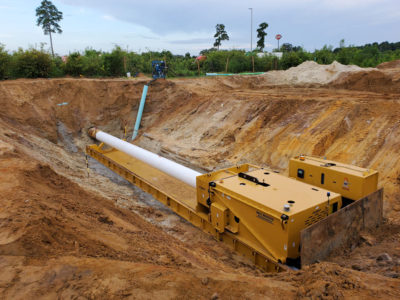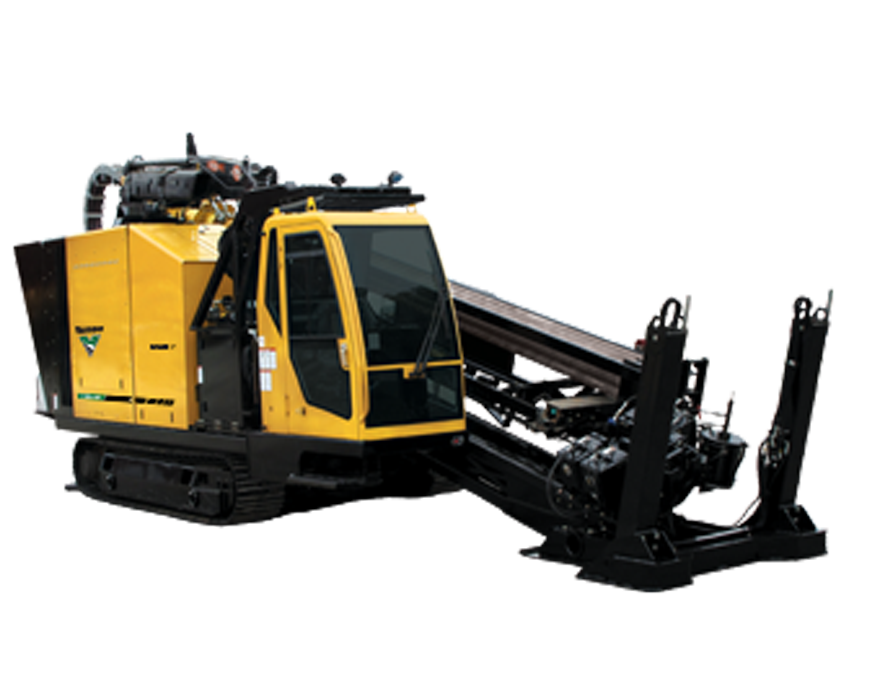Horizontal directional drilling (HDD) and auger boring are excellent trenchless installation options for large-diameter utilities and pipelines. However, each has areas where they are superior to the other for specific underground infrastructure projects.
According to Tod Michael, product manager for trenchless products at Vermeer, and Dave Gasmovic, business development manager at Vermeer MV Solutions, Inc., HDD and auger boring complement each other for larger diameter boring projects. “While directional drilling is used for everything from small fiberoptic conduit to large oil and gas pipeline installations, once the utility being installed is around the 24-inch to 60-inch (60.9-cm to 152.4-cm) diameter range or larger, auger boring begins to be a viable option,” said Gasmovic.
Michael added that water, sewer, electrical and natural gas, as well as oil and gas pipelines, are all applications that fall into this size category. “The project’s location, ground material, distance and grade requirements are factors in determining which method should be used,” he explained.
To determine when to employ an HDD rig or auger boring machine, it’s important to understand each trenchless method’s advantages and drawbacks.
Advantages of HDD for midsize to large-diameter bores
HDD is the industry’s preferred trenchless method for installing buried utilities over long distances. “The distance and diameter of product midsize and large maxi-rig drills can handle, as well as the ability to steer, are the main reasons why HDD is so widely used,” said Michael. “HDD bores up to 8,000 feet (2,438.4 m) and over 30 inches (76.2 cm) in diameter are becoming more and more common these days. These types of bores are being done in urban areas, as well as in more rural areas, where there may be environmental concerns about digging.”
When (and when not) to use directional drilling
Wetlands, rivers, lakes and mountainous terrain are a few examples of some of the environmental areas where HDD is commonly called upon. However, thanks to powerful tracking technology and all the different types of tooling options available for drilling rigs, there are few conditions where HDD cannot be used.
Michael said ground conditions aren’t the reason why most HDD contractors would choose another trenchless method, like auger boring, for doing larger diameter trenchless work. Instead, the decision comes down to project details, including what the bore is crossing under, bore distance, product bend radius and required setback distance to get to the desired depth.
“With HDD boring, crews use drilling fluids to flush the bore path before the utility, casing and conduit are pulled into place,” Michael explained. “To allow the drilling fluid to circulate during pullbacks, crews need to allow extra space downhole — typically around a 25% overcut. On most projects, having that extra space left between the installed line and the ground is of no concern. However, some engineers involved on projects crossing under major roadways and railroads prefer auger boring in these areas.”
On larger diameter bores, there are equipment requirements other than just an HDD — drilling fluid mixing systems, mud recycling systems/reclaimers, excavators for handling drill rods and so on. These equipment requirements may be another reason why a contractor may want to consider auger boring for shorter distances.
Finally, the drill rod and installed product’s allowable bend radius influences the drill’s setback distance. “Deeper depths and rigid piping, like steel casing, require longer bore shots,” said Michael. He adds that on longer jobs, that’s usually fine, but when a bore is just crossing under a roadway or railway, there may not be enough setback distance — and even if there is, HDD may not be as cost-efficient as another trenchless method.
Advantages of auger boring
Auger boring is one of the oldest forms of trenchless technology. It continues to be relevant today because it’s cost-effective over distances of 600 feet compared to other large-diameter installation methods. It also continues to be used because the work can be done on grade for sewer work.
“Auger boring machines can install casing ranging from 4 inches to 72 inches (10.2 cm to 182.9 cm) in diameter, and up to 600 feet (182.9 m) in length,” explained Gasmovic. “That kind of size versatility means auger boring can be used to install everything from a small sewer or waterline placed inside a steel casing all the way up to a culvert under a railroad track or highway.”
Gasmovic also noted that auger boring is one of the few trenchless methods in which contractors can precisely control the grade of the product being installed. “Many communities have gravity sewer systems, and the grade of lines becomes incredibly important when making repairs or expanding a system,” he explained. “Auger boring machines give contractors a high level of grade control. Also, there is the option of using a steering system like the On-Target Steering (OTS) System or Steerable Rock System (SRS). Using one of those two systems — the OTS for dirt, sand and clay, or the SRS for solid rock or hard cobble — crews can track the grade of the casing being installed, as well as steer it from left to right.”
Also, since auger boring is typically performed from an entry pit dug at a specified depth, as well as an exit pit at a similar depth, setback distance is minimal.
When (and when not) to use auger boring
Unlike with HDD bores that pull the product back into place, auger boring machines push casing through the borehole as it’s being dug without the use of drilling fluid. There is minimal overcut between the casing and ground material and no positive pressure being delivered to the ground around the bore hole. It’s an ideal situation for boring under major roadways and railroads because it helps reduce the risk of swelling that can be caused by other trenchless methods, as well as helps reduce concerns about inadvertent returns.
Also, since a bore’s grade can be controlled, auger boring is the excellent trenchless method for working sewer and water lines. “In many instances, municipalities can avoid having to dig up streets when making lateral sewer repairs,” said Gasmovic. “Skilled trenchless crews will dig an entry pit, drop in an auger boring machine with a steerable head and drive a new lateral in place exiting through an existing maintenance hole. All this can be done maintaining grade control.”
Gasmovic went on to say that while a lot of trenchless work can be done using auger boring machines, maximum bore lengths usually cap out at around 600 feet (182.9 m) depending on ground conditions. Also, almost all auger boring involves driving steel casings. So, while some steering adjustments can be made, all bores need to be a practically straight shot.
“Another consideration that contractors need to keep in mind when considering auger boring is the area’s existing water table,” Gasmovic added. “Bore done at depth near the water table can be a real challenge because crews have to pump the water from the entry and exit pits.”
An ideal pairing of trenchless technologies
Michael and Gasmovic both agree that choosing between HDD and auger boring is fairly straightforward. Long distances with lots of steering involved are better suited for a directional drill. Shorter, larger diameter bores under roadways and railroads, as well as on-grade work, are good situations to use an auger boring machine. On many water, sewer and pipeline projects, the answer may be to use both trenchless methods.
If you have questions about HDDs or auger boring machines, contact your local Vermeer dealer. They can help you find the right size Vermeer HDD or auger boring machine. You can also learn more about Vermeer drills and McLaughlin auger boring machines.
Vermeer Corporation and Vermeer MV Solutions, Inc. reserve the right to make changes in product engineering, design and specifications; add improvements; or discontinue manufacturing or distribution at any time without notice or obligation. Equipment shown is for illustrative purposes only and may display optional accessories or components specific to their global region. Please contact your local Vermeer dealer for more information on machine specifications.
Vermeer and the Vermeer logo are trademarks of Vermeer Manufacturing Company in the U.S. and/or other countries. McLaughlin is a trademark of McLaughlin Group Inc. © 2021 Vermeer Corporation. All Rights Reserved.

